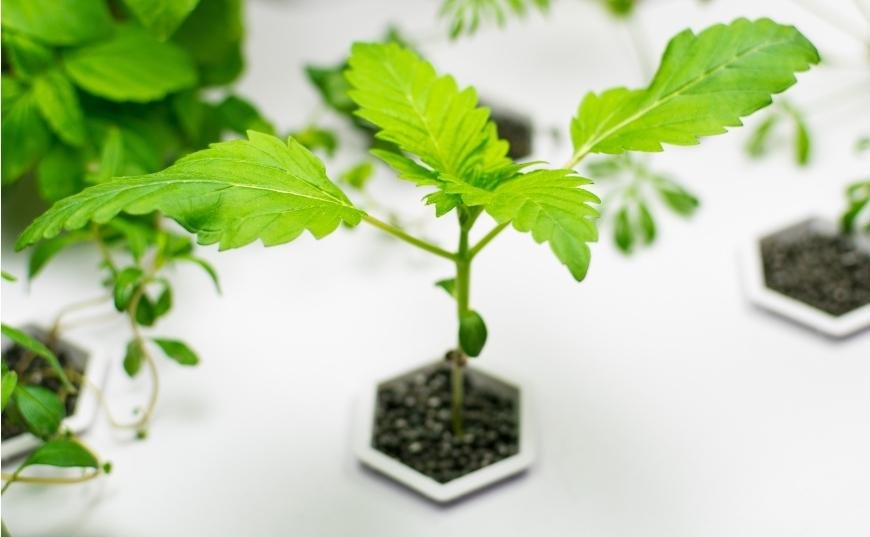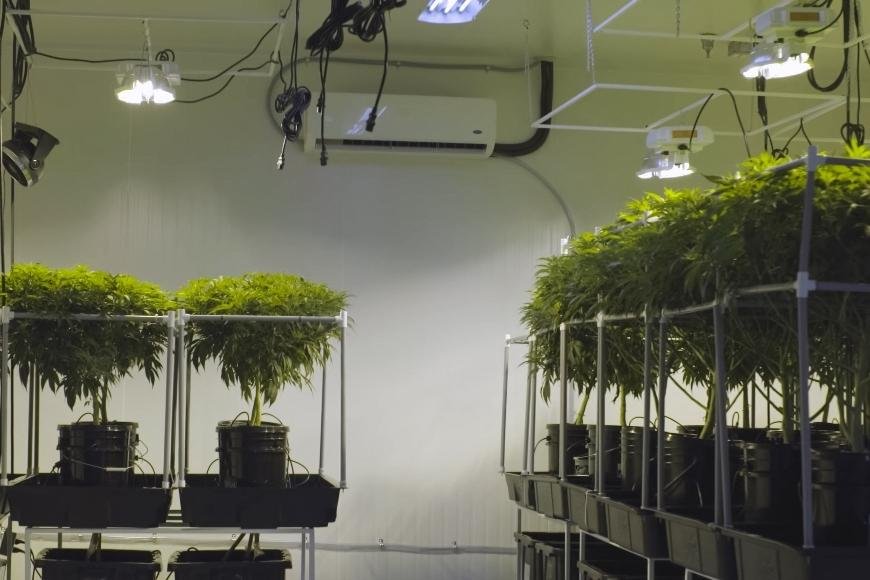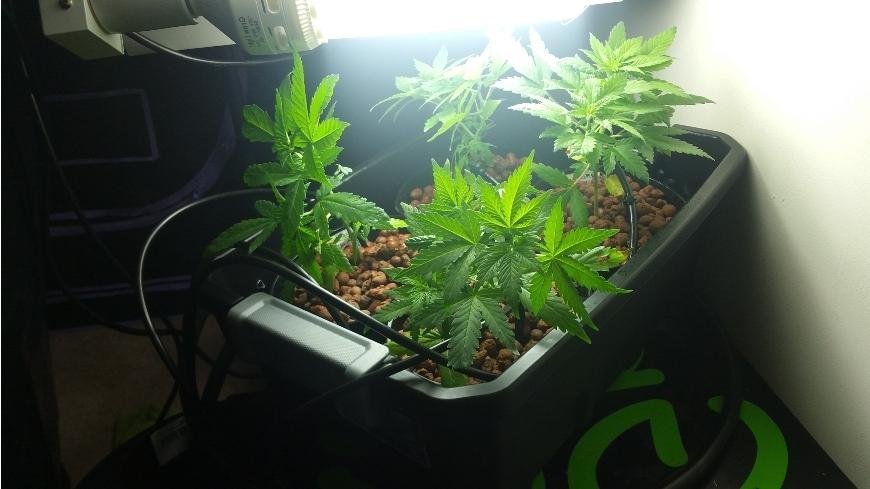The Best Hydroponic Systems for Growing Cannabis
Discover the best hydroponic systems for growing cannabis, including deep water culture, aeroponics, and more to maximize your yield and potency.

When it comes to the best hydroponic systems for growing cannabis, there are several options that can provide impressive results. In this piece, we'll investigate a few hydroponic frameworks that have demonstrated successful in creating top-notch cannabis plants.
Throughout this article, you'll learn about Deep Water Culture (DWC), Aeroponics, Drip Irrigation, Ebb and Flow Systems, and Nutrient Film Technique (NFT). Each of these methods has its own unique advantages when it comes to successfully grow cannabis in a controlled environment.
By selecting the optimal hydroponic system for cannabis growth based on your individual needs, you can maximize the benefits of each method.
Table of Contents:
- What is Hydroponic Growing?
- The Advantages of Hydroponics
- The Importance of Choosing the Right System
- Deep Water Culture
- Aeroponics
- Drip Irrigation
- Ebb and Flow Systems
- Nutrient Film Technique
- Choosing a Hydroponic System
- Frequently Asked Questions The Best Hydroponic Systems for Growing Cannabis
- Conclusion
What is Hydroponic Growing?
Hydroponic growing is a method of cultivating plants without the use of soil. Instead, plants are grown in an inert medium such as coco coir, perlite, or rockwool and provided with nutrient-rich water solutions to meet their growth requirements. This innovative approach to gardening offers several advantages over traditional soil-based cultivation methods.
The Advantages of Hydroponics
- Faster Growth: Plants grown hydroponically tend to grow faster than those cultivated in soil due to the optimized delivery of nutrients and oxygen directly to their roots.
- Better Yields: Improved growth rates often translate into higher yields for hydroponically-grown cannabis plants compared to their soil-grown counterparts.
- Water Efficiency: Hydroponic systems typically use less water than traditional gardens since they recirculate nutrient solutions and minimize evaporation losses. This makes them more environmentally friendly and cost-effective.
- Pest Control: The absence of soil eliminates many common pests that can plague cannabis growers, reducing the need for chemical pesticides and making it easier to maintain a healthy garden environment.
The Importance of Choosing the Right System
Selecting the appropriate hydroponic system for your cannabis garden is crucial for achieving optimal results. Before settling on a hydroponic system, it's essential to weigh up factors such as the size of your grow space, budget restrictions, expertise level and desired results. In this article, we'll explore some popular options like deep water culture (DWC), aeroponics, drip irrigation systems, ebb and flow systems, and nutrient film technique (NFT) to help you make an informed choice.
Hydroponic growing is a method of cultivating plants without soil, using mineral nutrient solutions in water. Hydroponics has transformed the way we cultivate crops, and it can be utilized to grow cannabis in one's own residence. Deep Water Culture (DWC) is an even more advanced form of hydroponics that offers some unique benefits for growers looking to maximize their yields with minimal effort.

Deep Water Culture
If you're looking for a simple yet effective hydroponic system to grow your cannabis plants, deep water culture (DWC) might be the perfect choice. This method involves suspending the roots of your plants in nutrient-rich, oxygenated water. Let's dive into the benefits and drawbacks of DWC systems for cannabis cultivation.
Benefits of Deep Water Culture
- Faster growth: Since DWC provides direct access to nutrients and oxygen, cannabis plants tend to grow faster compared to soil-based methods. In fact, some growers have reported up to a 25% increase in growth rate using this technique.
- Easier maintenance: With no soil or growing medium involved, there is less chance of pests and diseases affecting your crop. Additionally, pH levels are easier to monitor and adjust as needed.
- Better yields: The increased growth rate often translates into higher yields per plant when using deep water culture systems.
Potential Drawbacks of Deep Water Culture
- Vulnerability to power outages: Since DWC relies on continuous circulation of nutrient-rich water via an air pump or submersible pump, any interruption in power supply can quickly lead to root damage due to lack of oxygenation.
- Risk of overwatering: Although it may seem counterintuitive given that the roots are submerged in water throughout their life cycle, overwatering can still occur if proper care isn't taken with managing dissolved oxygen levels within the reservoirs.
- Higher initial investment: DWC systems can be more expensive to set up compared to other hydroponic methods, particularly if you opt for a pre-built system.
Tips for Successful Deep Water Culture Cannabis Growth
To maximize the potential of your DWC setup, consider these tips:
- Maintain optimal water temperature: Aim for a water temperature between 65°F and 70°F (18°C - 21°C) to ensure proper nutrient uptake and prevent root rot.
- Aerate the reservoirs properly: Invest in high-quality air stones or diffusers that provide adequate oxygenation throughout the entire reservoir. This will help avoid overwatering issues and promote healthy root growth.
Deep Water Culture is a great way to grow cannabis with minimal effort and maximum results. Aeroponics, on the other hand, provides an even more efficient method of growing by utilizing water-based nutrient solutions without soil or any medium for plant roots.
Aeroponics
When it comes to growing cannabis, aeroponic systems offer a unique and highly efficient method for cultivating your favorite strains. This article will explore the benefits and drawbacks of aeroponic systems for cannabis growth.
What is Aeroponics?
Aeroponics is a soilless cultivation technique that suspends plant roots in air while providing them with essential nutrients through a fine mist or spray. This allows plants to receive oxygen directly from the atmosphere, promoting rapid growth and high yields.
The Advantages of Aeroponic Systems
- Faster Growth: Due to increased oxygen availability, plants grown in aeroponic systems typically grow faster than those cultivated in other hydroponic setups or traditional soil-based methods.
- Better Nutrient Uptake: The nutrient-rich mist sprayed onto the roots ensures that plants receive all necessary elements without having to compete with other organisms found in soil.
- Disease Prevention: Since there's no soil involved, many common pests and diseases are less likely to affect your cannabis crop when using an aeroponic system.
- Ease of Maintenance: With fewer components compared to some other hydroponic systems (such as ebb-and-flow), maintaining an aeroponic setup can be relatively simple once you've established proper routines for monitoring pH levels and nutrient concentrations.
The Disadvantages of Aeroponic Systems
- Mechanical Failures: Aeroponic systems rely on pumps and misters to deliver nutrients, which can be prone to failure. Regular maintenance checks are crucial to prevent system breakdowns that could harm your cannabis plants.
- Initial Cost: Setting up an aeroponic system can be more expensive than other hydroponic methods due to the specialized equipment required.
- Sensitivity of Roots: The exposed roots in an aeroponic setup may be more susceptible to damage from temperature fluctuations or physical disturbances compared with those grown in soil or water-based environments.
Tips for Successful Cannabis Growth Using Aeroponics
To maximize the benefits of using an aeroponic system for growing cannabis, consider these helpful tips:
- Maintain proper nutrient concentrations and pH levels: Regularly monitoring and adjusting as needed will ensure optimal growth conditions for your cannabis plants.
- Select a high-quality mister or spray nozzle that produces fine droplets without clogging: This will help provide even coverage of nutrients across all plant roots while minimizing waste.
- Incorporate a backup power source (such as a generator) into your setup: So you're prepared if there's ever an unexpected outage that could disrupt essential functions like nutrient delivery and air circulation within the grow space.
Aeroponics is a successful technique for cultivating cannabis, in which the roots are suspended and supplied with nutrients without any contact. Drip irrigation can be a reliable means of providing sustenance to cannabis without the need for direct contact with its root system.
Drip Irrigation
When it comes to efficient and water-saving hydroponic systems, drip irrigation stands out as a popular choice for cannabis cultivation. This method involves delivering nutrient-rich water directly to the roots of your plants through a network of tubes and emitters. Let's dive into the advantages and disadvantages of drip irrigation systems for growing cannabis.
Advantages of Drip Irrigation Systems
- Precision: By providing nutrients directly to the root zone, you can ensure that each plant receives exactly what it needs in terms of water and nutrients, leading to optimal growth conditions.
- Water Efficiency: Drip irrigation is known for its ability to conserve water by minimizing evaporation losses. This system can save up to 60% more water compared with traditional methods.
- Ease of Automation: With drip irrigation systems, you can easily automate watering schedules using timers or smart controllers. This allows you more time focusing on other aspects like pruning or pest control while ensuring consistent hydration levels throughout your grow cycle.
- Versatility: These systems are adaptable across various grow mediums such as coco coir, perlite, or even soilless mixes making them suitable for different types of growers' preferences.
Disadvantages of Drip Irrigation Systems
- Maintenance Requirements: The small emitters used in these setups may clog over time due to mineral buildup or sediment from the nutrient solution. Regular upkeep and servicing is essential for the optimal performance of your system.
- Initial Cost: Setting up a drip irrigation system can be more expensive than other hydroponic methods due to the need for pumps, tubing, emitters, and controllers. However, this investment may pay off in terms of water savings and automation capabilities over time.
Tips for Optimizing Drip Irrigation Systems
To get the most out of your drip irrigation setup when growing cannabis, consider these helpful tips:
- Monitor pH Levels: As with any hydroponic system, maintaining proper pH levels is crucial for optimal nutrient uptake by your plants. Invest in a reliable pH meter to ensure consistent readings throughout your grow cycle.
- Select Appropriate Emitters: Choose emitters that provide an even distribution of nutrients across all plants while minimizing clogging risks. Look into pressure-compensating emitters which maintain consistent flow rates despite changes in water pressure within the system.
- Avoid Overwatering: While it's important to keep roots hydrated consistently using drip irrigation systems; avoid overwatering as it can lead to root rot or oxygen deprivation issues. Adjust watering schedules according to plant size and growth stage requirements accordingly.
Drip-irrigation can be an economical solution for supplying moisture to cannabis plants. With that in mind, the next heading will explore ebb and flow systems which offer a slightly different approach to hydroponic growing.
Ebb and Flow Systems
The ebb and flow system, also known as flood and drain, is a widely-used hydroponic setup for cultivating cannabis. This method involves periodically flooding a grow tray with nutrient-rich water before draining it back into a reservoir. The process allows plants to receive adequate nutrients while preventing root rot caused by overwatering.
Benefits of Ebb and Flow Systems
- Efficient Water Usage: By recycling water in a closed-loop system, ebb and flow setups minimize waste, making them an eco-friendly choice for cannabis cultivation.
- Fewer Pests: The periodic flooding helps deter pests like fungus gnats that thrive in consistently moist environments.
- Versatility: Ebb and flow systems can accommodate various types of growing media such as coco coir or perlite, allowing growers to tailor their setup based on personal preferences or plant requirements.
Potential Drawbacks of Ebb and Flow Systems
- Mechanical Failures: Since these systems rely on pumps to move water between the reservoirs, they are susceptible to mechanical failures that could disrupt your cannabis growth cycle. Regular maintenance checks can help mitigate this risk.
- Larger Footprint: Ebb-and-flow setups typically require more space than other hydroponic methods due to the need for separate trays for each stage (flooding/draining).
Ebb and Flow Systems are an efficient way to grow cannabis, as they provide a steady supply of nutrients and oxygen for the plants. Nutrient Film Technique is another popular hydroponic system that can be used to effectively cultivate marijuana.
Nutrient Film Technique
One of the most popular and efficient hydroponic systems for growing cannabis is the Nutrient Film Technique (NFT). This system involves a never-ending supply of nutrient-infused liquid cascading over the roots, supplying them with all their necessary requirements for flourishing. Let's dive into some advantages and disadvantages of NFT systems.
Advantages
- Efficient use of space: NFT systems are perfect for those who have limited space available, as you can grow multiple plants in a compact area. The horizontal orientation allows for better light distribution across all plants.
- Faster growth rates: Due to constant access to nutrients and oxygen, cannabis plants grown using NFT often experience faster growth rates compared to other hydroponic methods or soil-based cultivation.
- Easier maintenance: With no growing medium involved, there's less chance for pests or diseases to develop within your system. Plus, it makes cleaning much easier.
Disadvantages
- Vulnerability to power outages: Since an NFT system relies heavily on electricity for maintaining proper water flow and circulation, any interruption in power supply could lead to detrimental effects on your cannabis crop.
- Limited support structure: As there is no solid medium holding up your plant's root mass in an NFT system, taller or heavier strains may require additional support structures such as trellises or stakes.
- Steep learning curve: NFT systems can be a bit more challenging for beginners, as they require careful monitoring and adjustments to maintain optimal nutrient levels and pH balance. Learn more about the importance of maintaining proper pH levels in hydroponic systems.
Tips for Successful Cannabis Growth with NFT Systems
To maximize your success when using an NFT system, keep these tips in mind:
- Choose appropriate strains: Opt for cannabis strains that are known to perform well in hydroponic environments or have a smaller stature to avoid overcrowding your grow space.
- Maintain water quality: Regularly monitor and adjust the nutrient solution's pH level, temperature, and electrical conductivity (EC) to ensure optimal growth conditions. Invest in a reliable water pump and air stones to promote oxygenation within the system.
- Cleanliness is key: Keep all components of your NFT system clean by regularly flushing out old nutrient solutions, sanitizing reservoirs, channels, and pumps. This will help prevent any buildup of algae or harmful pathogens that could negatively impact plant health.
Nutrient Film Technique is an efficient and effective hydroponic system that allows for optimal growth of cannabis. Selecting the proper hydroponic set-up is essential for achieving a fruitful harvest.

Choosing a Hydroponic System
Having assessed the various hydroponic systems for cultivating cannabis, it's time to select one that best meets your requirements. When selecting a system, consider factors such as available space, budget, and level of experience. To aid you in making a well-thought-out choice, let's go over some essential points to remember.
Evaluating Your Space
The first step in choosing a hydroponic system is assessing the amount of space you have at your disposal. Some systems require more room than others due to their design or necessary equipment. For example, deep water culture (DWC) setups can be quite large and may not be suitable for small spaces like closets or apartments. On the other hand, nutrient film technique (NFT) systems are typically more compact and better suited for limited areas.
Budget Considerations
Your monetary plan will also be a noteworthy factor in deciding which hydroponic system is best for you. Investment in the necessary components and supplies is needed for any hydroponic system, however certain configurations can be more economical over time. For instance,drip irrigation systems tend to use less water and nutrients compared to deep water culture or ebb-and-flow setups.
- Affordable options: Drip Irrigation Systems & Nutrient Film Technique (NFT).
- Moderate price range: Ebb-and-Flow Systems & Deep Water Culture (DWC).
- Higher-end options: Aeroponic Systems.
Level of Experience
Your experience with hydroponic growing will also influence your choice. Some systems are more beginner-friendly, while others may require a higher level of expertise to maintain optimal growth conditions. For instance, aeroponics can be quite complex and is generally better suited for experienced growers. Conversely, DWC and ebb-and-flow systems are typically recommended for those just starting out in hydroponics due to their uncomplicated nature.
Tips for Beginners:
- Research extensively before starting your hydroponic journey.
- Select a system that aligns with your available space, budget, and skill level.
- Consider joining online forums or communities where you can ask questions and learn from fellow cannabis cultivators' experiences.
- Purchase high-quality equipment and supplies to ensure successful plant growth and avoid common pitfalls associated with cheaper alternatives.
Frequently Asked Questions The Best Hydroponic Systems for Growing Cannabis
What is the best hydroponic system to grow cannabis?
The best hydroponic system for growing cannabis depends on your individual needs and preferences. However, Deep Water Culture (DWC) and Aeroponics are often considered top choices due to their efficiency, high yields, and ease of use. Research various systems before deciding which one suits you best.
Which hydroponic system yields the most?
Aeroponic systems typically yield the highest amount of cannabis compared to other methods. This is because they provide optimal oxygenation and nutrient delivery directly to plant roots, resulting in faster growth rates and larger harvests. However, it's essential to carefully manage an aeroponic setup for maximum success.
Conclusion
Hydroponic cultivation can offer a great means of creating ideal growth circumstances for cannabis plants. With the right setup and maintenance routine, growers can enjoy high-quality yields while avoiding many common problems associated with soil cultivation. By carefully considering factors such as available space, budget, level of experience and desired results when selecting the best hydroponic system for their needs, growers will be well on their way to cultivating successful crops that meet or exceed expectations.




















































































































